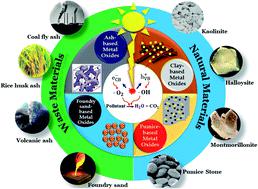Our official English website, www.x-mol.net, welcomes your feedback! (Note: you will need to create a separate account there.)
Fly ash-, foundry sand-, clay-, and pumice-based metal oxide nanocomposites as green photocatalysts
RSC Advances ( IF 3.9 ) Pub Date : 2021-09-17 , DOI: 10.1039/d1ra05647f Bui Thanh Son 1 , Nguyen Viet Long 1 , Nguyen Thi Nhat Hang 1
RSC Advances ( IF 3.9 ) Pub Date : 2021-09-17 , DOI: 10.1039/d1ra05647f Bui Thanh Son 1 , Nguyen Viet Long 1 , Nguyen Thi Nhat Hang 1
Affiliation

|
Metal oxides possess exceptional physicochemical properties which make them ideal materials for critical photocatalytic applications. However, of major interest, their photocatalytic applications are hampered by several drawbacks, consisting of prompt charge recombination of charge carriers, low surface area, inactive under visible light, and inefficient as well as expensive post-treatment recovery. The immobilization of metal oxide semiconductors on materials possessing high binding strength eliminates the impractical and costly recovery of spent catalysts in large-scale operations. Notably, the synthesis of green material (ash, clay, foundry sand, and pumice)-based metal oxides could provide a synergistic effect of the superior adsorption capacity of supporting materials and the photocatalytic activity of metal oxides. This phenomenon significantly improves the overall degradation efficiency of emerging pollutants. Inspired by the novel concept of “treating waste with waste”, this contribution highlights recent advances in the utilization of natural material (clay mineral and pumice)- and waste material (ash and foundry sand)-based metal oxide nanocomposites for photodegradation of various pollutants. First, principles, mechanism, challenges towards using metal oxide as photocatalysts, and immobilization techniques are systematically summarized. Then, sources, classifications, properties, and chemical composition of green materials are briefly described. Recent advances in the utilization of green materials-based metal oxide composites for the photodegradation of various pollutants are highlighted. Finally, in the further development of green materials-derived photocatalysts, we underlined the current gaps that are worthy of deeper research in the future.
中文翻译:

粉煤灰、铸造砂、粘土和浮石基金属氧化物纳米复合材料作为绿色光催化剂
金属氧化物具有卓越的物理化学性质,这使其成为关键光催化应用的理想材料。然而,最令人感兴趣的是,它们的光催化应用受到几个缺点的阻碍,包括载流子的快速电荷重组、低表面积、在可见光下不活跃以及低效且昂贵的后处理恢复。将金属氧化物半导体固定在具有高结合强度的材料上,消除了大规模操作中废催化剂的不切实际且昂贵的回收。值得注意的是,基于绿色材料(灰、粘土、铸造砂和浮石)的金属氧化物的合成可以提供支撑材料的优异吸附能力和金属氧化物的光催化活性的协同效应。这种现象显着提高了新兴污染物的整体降解效率。受“以废治废”这一新概念的启发,本文重点介绍了利用天然材料(粘土矿物和浮石)和废料(灰和铸造砂)基金属氧化物纳米复合材料光降解各种污染物的最新进展。首先,系统总结了金属氧化物作为光催化剂的原理、机理、挑战以及固定化技术。然后简要介绍了绿色材料的来源、分类、性能和化学成分。重点介绍了利用基于绿色材料的金属氧化物复合材料光降解各种污染物的最新进展。最后,在绿色材料光催化剂的进一步开发中,我们强调了当前值得未来进行更深入研究的差距。
更新日期:2021-09-17
中文翻译:

粉煤灰、铸造砂、粘土和浮石基金属氧化物纳米复合材料作为绿色光催化剂
金属氧化物具有卓越的物理化学性质,这使其成为关键光催化应用的理想材料。然而,最令人感兴趣的是,它们的光催化应用受到几个缺点的阻碍,包括载流子的快速电荷重组、低表面积、在可见光下不活跃以及低效且昂贵的后处理恢复。将金属氧化物半导体固定在具有高结合强度的材料上,消除了大规模操作中废催化剂的不切实际且昂贵的回收。值得注意的是,基于绿色材料(灰、粘土、铸造砂和浮石)的金属氧化物的合成可以提供支撑材料的优异吸附能力和金属氧化物的光催化活性的协同效应。这种现象显着提高了新兴污染物的整体降解效率。受“以废治废”这一新概念的启发,本文重点介绍了利用天然材料(粘土矿物和浮石)和废料(灰和铸造砂)基金属氧化物纳米复合材料光降解各种污染物的最新进展。首先,系统总结了金属氧化物作为光催化剂的原理、机理、挑战以及固定化技术。然后简要介绍了绿色材料的来源、分类、性能和化学成分。重点介绍了利用基于绿色材料的金属氧化物复合材料光降解各种污染物的最新进展。最后,在绿色材料光催化剂的进一步开发中,我们强调了当前值得未来进行更深入研究的差距。



























 京公网安备 11010802027423号
京公网安备 11010802027423号